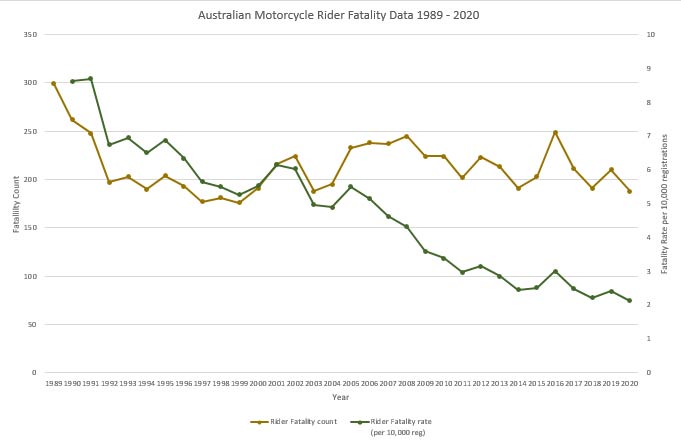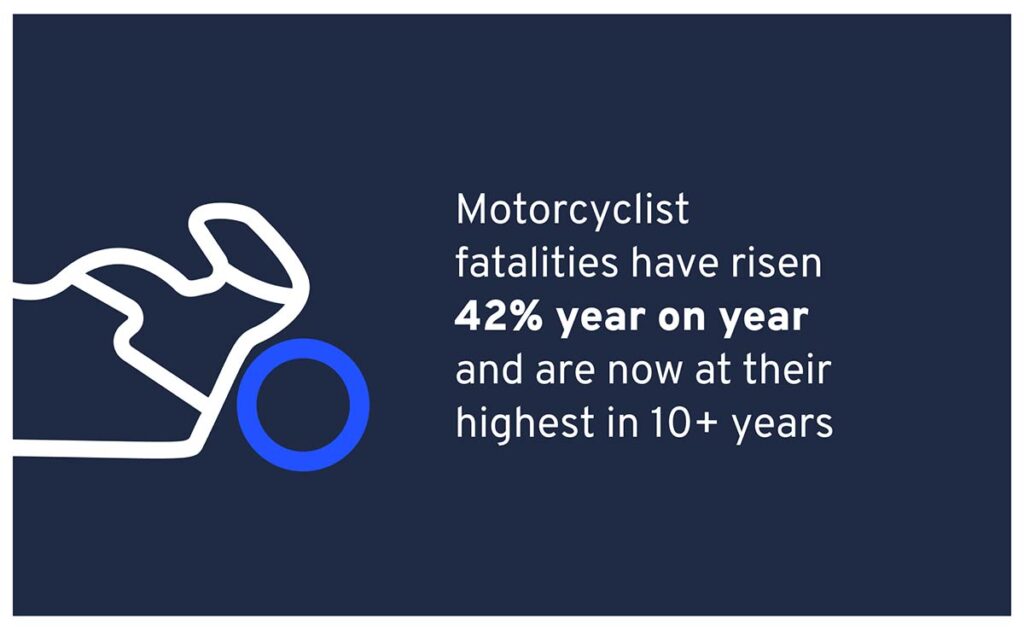Australian Motorcycle Crash Data
We receive numerous emails each day asking for sponsored articles to be posted here on MCNews.com.au, along with various other angles PR and SEO companies work in their quest to obtain valuable links through to their sites. We generally ignore them all. Law firms offer the most money for such things which is why you might notice some sites offering plenty of articles with a legal angle.
Some of the most unique approaches also come from law firms and one recently landed in our inbox with the headline ‘Motorcyclist fatalities up 42% year on year, highest rate in 10+ years | LHD Report’. Obviously that is quite a startling headline that would generally garner plenty of clicks, as it was designed to do, but we thought we might see how they have come up with their figures.
Their message was as follows and included the accompanying graphics
Using data from the Australian Road Deaths Database (ARDD), LHD Lawyers have analysed road transport crash fatality data as reported by the police to compare the first half of 2021 with trends over a ten year period (2011-2021).
The data has revealed some truths, in which we think the MCNews readers will find interesting, including:
-
Alarmingly, motorcyclist fatalities have risen 42% year on year and are now at their highest in 10+ years
-
Road users aged 40-64 have made up 31% of all Australian road fatalities in the last 10 years. This segment increases among cyclists and motorcyclists, where 44% of deaths are Generation X or Baby Boomers.
-
Road fatalities are up 7.5% in the first half of 2021 compared to last year
-
Saturday is the deadliest day, with 17.6% of road deaths occurring on this day
-
76% of all road deaths were male in H1 2021
They then subsequently followed this up with this.
A recent study analysing government data on road-related fatalities has shown how different road users, including motorcyclists, can stay safe on the roads by understanding common traits of traffic fatalities and being aware of the risks.
The research piece, conducted by LHD Lawyers, used 10 years of data and almost 12,000 crash reports from the Australian Road Deaths Database (ARDD) to help road users understand when & how fatal accidents happen.
While overall fatal road accidents have been falling over a 10 year period, a surge in motorcycle road use has led to a 42% increase in deaths when comparing H1 2021 against H1 2020.
 Sunday is the most dangerous day to be on a motorcycle
Sunday is the most dangerous day to be on a motorcycle
21% of all motorcyclist accidents occur on a Sunday, with 41% occuring on the weekend. The least number of accidents occur on Mondays, which equals 10%. Interestingly the amount of accidents increase as the week goes on.
There is a much clearer pattern of weekend accidents for motorcyclists compared to other road users, with the most dangerous days being Wednesday and Thursday for pedal cyclists.
| Day of week | All Road Users | Motorcyclists | Pedal Cyclists |
| Monday | 12% | 10% | 12% |
| Tuesday | 12% | 11% | 15% |
| Wednesday | 13% | 11% | 16% |
| Thursday | 13% | 12% | 16% |
| Friday | 16% | 14% | 11% |
| Saturday | 18% | 20% | 15% |
| Sunday | 16% | 21% | 14% |
24% of all motorcycle fatalities occur between 2pm and 5pm
Afternoons are without question the most deadly times to be on the road for all users and motorcyclists in particular.
| Day of week | All Road Users | Motorcyclists | Pedal Cyclists |
| 0:00 | 3% | 2% | 1% |
| 1:00 | 3% | 2% | 0% |
| 2:00 | 2% | 1% | 0% |
| 3:00 | 2% | 1% | 1% |
| 4:00 | 2% | 0% | 1% |
| 5:00 | 3% | 1% | 3% |
| 6:00 | 4% | 3% | 8% |
| 7:00 | 4% | 3% | 8% |
| 8:00 | 4% | 3% | 11% |
| 9:00 | 4% | 5% | 7% |
| 10:00 | 5% | 5% | 7% |
| 11:00 | 5% | 7% | 5% |
| 12:00 | 5% | 8% | 3% |
| 13:00 | 5% | 7% | 3% |
| 14:00 | 6% | 8% | 5% |
| 15:00 | 7% | 8% | 6% |
| 16:00 | 6% | 8% | 7% |
| 17:00 | 6% | 7% | 6% |
| 18:00 | 5% | 5% | 6% |
| 19:00 | 5% | 4% | 3% |
| 20:00 | 4% | 3% | 3% |
| 21:00 | 4% | 3% | 3% |
| 22:00 | 3% | 3% | 1% |
| 23:00 | 3% | 2% | 1% |
27% of all fatalities occur on roads with 100km speed limit
33% of all road fatalities occur on roads with a 100km per hour speed limit with 27% of these fatalities being motorcyclists. Unsurprisingly, only 1% of deaths occur on roads under 30km per hour.
| Road Speed | All Road Users | Motorcyclists | Pedal Cyclists |
| 30km/h (or under) | 1% | 1% | 2% |
| 40km/h | 1% | 2% | 2% |
| 50km/h | 11% | 14% | 23% |
| 60km/h | 17% | 24% | 29% |
| 70km/h | 5% | 6% | 5% |
| 80km/h | 15% | 19% | 15% |
| 90km/h | 2% | 2% | 1% |
| 100km/h | 33% | 27% | 17% |
| 110km/h | 13% | 5% | 4% |
| 130km/h | 1% | 0% | 0% |
42% of motorcyclist accidents occur in major cities
Unsurprisingly, the largest share of deaths occur in major Australian cities, but 54% of are occuring in regional areas of some kind. Pedal cyclist deaths are far more skewed to city locations.
| Type of Area | All Road Users | Motorcyclists | Pedal Cyclists |
| Inner Regional | 32% | 33% | 16% |
| Major Cities | 34% | 42% | 69% |
| Outer Regional | 24% | 21% | 10% |
| Remote Australia | 4% | 2% | 2% |
| Very Remote Areas | 5% | 3% | 3% |
“The biggest trend we see is consistency,” says John Abouchrouche, Managing Director at LHD Lawyers. “Despite best efforts, an alarming number of Australians continue to lose their lives on our roads each year and even more are seriously injured. With 16% of our clients coming to us after a motoring injury, we see all too often the devastating consequences of poor decision making on the road”.
In reality the trend is a positive one for motorcycling
Rather than take these figures at face value we thought it would be wise to do some digging of our own, and enlisted the help of Australian Motorcycle Council Chairman, Shaun Lennard, to try to sort the wheat from the chaff and interpret the data available in regards to motorcycle crashes in Australia.
AMC focussed on the headline claim that ‘‘Motorcyclist fatalities up 42% year on year, highest rate in 10+ years’.
They found that, notwithstanding the significant growth in registrations since 2004, the number of deaths has remained much the same.
AMC Chairman Shaun Lennard
The Bureau of Infrastructure and Transport Research Economics (BITRE) publishes detailed information on Australia’s road toll – every month and then a detailed annual analysis. The focus is mostly on trends – usually looking at five years or more.
Motorcycle fatalities have not risen 42% year on year. We have looked closely at the LHD report and the BITRE data to understand where their figure has come from.
It’s true that motorcycle deaths in the first six months of 2021 were 42% higher than the first six months of 2020. January to June 2020, the total was 93. Over the first six months of 2021, it was 132.
However, looking at a narrow set of figures can give a skewed view, and that’s why governments and others generally look at five year trends when making any road safety assessment.
Let’s instead look at some five-year figures and trends. The five year average for motorcycle deaths in 2010 was 233. The five year average at the end of 2020 was 210.
The highest number of deaths in the past decade was 249, in 2016 – and we note that was the highest in the past 20 years.
In 2020, the number of motorcycle rider deaths was 190.
Over the past ten years, the number of deaths has reduced on average by 0.6%, so the claim of a 42% increase – no matter which way you analyse numbers – is clearly an error.

When you overlay the registration data, which BITRE also does, the picture for motorcycle safety is actually one of significant improvement over any five or ten year period.
From 2010 to 2020, the number of registered motorcycles and scooters increased significantly – by 33% – from 661,000 in 2010 to 881,000 in 2020. So when you look at the death rate for riders, it has declined, and markedly.
In 2010, the fatality rate was 3.4 per 10,000 registrations. It was 2.2 by the end of 2020. That’s a 35% decrease in the fatality rate in ten years. That’s also a far cry from when it was around 14 per 10,000 riders 40 years ago, in 1980.
There’s still more that can and needs to be done, but as the total number of powered two wheelers on the roads in Australian gets close to 900,000 the overall picture for motorcycle safety is definitely encouraging.
So there you have it, we are not doing so bad after all…
Source: MCNews.com.au








